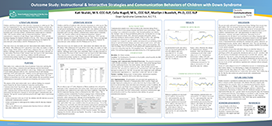Outcome Study: Instructional & Interactive Strategies and Communication Behaviors of Children with Down Syndrome

References
Abbeduto, L., Warren, S. F., & Conners, F. A. (2007). Language development in Down syndrome: From the prelinguistic period to the acquisition of literacy. Mental Retardation and Developmental Disabilities Research Reviews, 13, 247–261. [Article] San Francisco State University (SFSU): Check for F [PubMed]
Brady, N. C. (2008). AAC for children with Down syndrome and children with fragile X syndrome. Speech and Language Development and Intervention in Down Syndrome and Fragile X Syndrome. Baltimore, MD: Paul H. Brookes.
Burkhart, L., Musselwhite, C. (2001). Can We Chat? Co-Planned Sequenced Social Scripts. Litchfield Park: Special Communications.
Burkhart L., Sennott, S., Musselwhite, C., Cafiero, J. Aided Language Stimulation: Research to Practice, Paper presented at the Assistive Technology Industry Association Orlando Conference January 2010 Retrieved November 1, 2013
Buzolich, M., Russell, D., Lunger-Bergh, J., & McCloskey, D. (2010). Communication
Sampling and Analysis: A web based application. Web site http://www.acts-at.com/CSA.html.
Buzolich, M.J. Communication Sampling and Analysis. A publication of the
American Speech- Language-Hearing Association, Special Interest Division #12, September, 2009.
Buzolich, M.J. Interaction analyses of augmented and normal adult communicators. Publication #85-03, 722 University of California, San Francisco, University Microfilms International, Nov. 1983.
Elder, P. & Goossens’, C. (1994). Engineering Training Environments for Interactive Augmentative Communication: Strategies for Adolescents and Adults who are Moderately/Severely Developmentally Delayed. Birmingham, AL: Southeast Augmentative Communication Conference Publications.
Goossens’, C., Crain, S., & Elder, P. (1992) Engineering the Preschool Environment for Interactive, Symbolic Communication. Birmingham, AL: Southeast Augmentative Communication Conference Publications.
Jewitt, C. (2012) An Introduction to Using Video for Research. London: National Centre for Research Methods.
Kent-Walsh, J,, Murza, K.A., Malani, M.D., & Binger, C.. (2015). Effects of communication partner instruction on the communication of individuals using AAC: A meta-analysis. Augmentative and Alternative Communication 31 (4), 271-284
Kent, R. & Vorperian, H. Speech Impairment in Down Syndrome: A Review. Journal of Speech, Language, and Hearing Research, February 2013, Vol. 56, 178-210.
Kumin, L., Councill, C., & Goodman, M. (1999). Expressive vocabulary in young children with Down syndrome: From research to treatment. Infant-Toddler Intervention, 9, 87–100.
Launonen, K. (1996). Enhancing communication skills of children with Down syndrome: Early use of manual signs. In S. von Tetzchner & M. H. Jensen, (Eds.), Augmentative and Alternative Communication: European Perspectives (pp. 213–231). London, England: Whurr Publishers.
Light, J., Binger, C., Agate, T., & Ramsay, K. (1999). Teaching partner-focused questions to individuals who use augmentative and alternative communication to enhance their communicative competence. Journal of Speech and Hearing Research, 42, 241–255.
Light, J & Drager, K. (2010, November). Effects of AAC Intervention for Children with Down Syndrome. Seminar presented at American Speech Language Hearing Association. Philadelphia, PA.
Romski, M. A., & Sevcik, R. A. (1996). Breaking the speech barrier: Language development through augmented means. Baltimore: Brookes.
Sevcik, R., Romski, M.A., & Adamson, L. (1999). Measuring AAC interventions for individuals with severe developmental disabilities. Augmentative and Alternative Communication, 15:1, 38-44.
Solomon-Rice, Patti & Soto, Gloria. (2009). Language Modeling as an Efficacious Early Language Intervention Approach With Young Children Demonstrating Complex Communication Needs. Perspectives on Augmentative and Alternative Communication. 18. 21-27. 10.1044/aac18.1.21.
Wilkinson, K., Na, J.Y. Interprofessional practice in developing an AAC system for children with Down Syndrome. Perspective on Augmentative and Alternative Communication, June 2015, Vol.24, Volume 24, 114-122.
Ypsilanti, A., Grouios, G., Alevriadou, A., & Tsapkini, K. (2005). Expressive and receptive vocabulary in children with Williams and Down syndromes. Journal of Intellectual Disability Research, 49, 353–364.[Article] San Francisco State University (SFSU).